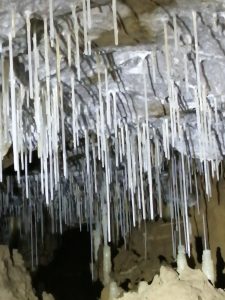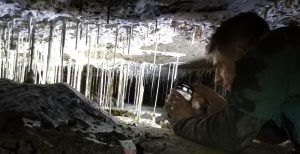Cape Kennedy, Lancaster Hole
Jason, James, Connor, Scott
Cape Kennedy is one of those bits of Easegill that I’ve been meaning to go and see for ages. The photos promise abundant straws, towering columns and even (hushed tones) a calcited bat skeleton. But more of that later.
It was a bit drizzly on the way to Lancaster Hole, but Connor made short work of rigging the pitch, and soon we were following the familiar route to Montague East. Some scruffy abseils took us all down the Stake Pot slope, and we were quickly reunited at the top. Here, instead of following the large open tunnel towards Bob’s Boss, we turned right into the smaller passages of The Rabbit Warren.
The next hour or so involves a bit of route finding, but nothing too difficult. The description from NFTFH is great for this, with just the right amount of detail. We followed sandy passages, traversed a narrow rift, ascended an old ladder at Canuck Climb, and then followed a series of larger chambers – Breakthrough, Bridge and Brew respectively. At some point we managed to bypass The Pit completely by keeping left, which is worth remembering for future forays.
At the Long Gallery the way on is through a narrow gap to the left, which leads to some higher traversing as a canyon develops below. We climbed down into Rat Pit Chamber, where there are some impressive calcite curtains. The last time Connor and I were here, we had turned left after this chamber to drop the 88 Foot Pitch, but this time we kept right and followed a small stream to Maple Leaf Junction. A bedding crawl to the left passes a crystal pool, and then a slit in the roof leads up a boulder slope into Cape Kennedy.
This chamber is really something to see, with stalagmites and some taller formations which wouldn’t have looked out of place in the Colonnades. After some photography we moved on to Fire Hydrant Chamber, where we began a fruitless search for the preserved bat skeleton. No sign! A bit of reading later confirmed that the bat is within the calcite of the actual Fire Hydrant formation, but we certainly struggled to find it.
The next chamber up is densely hung with straws, and is certainly worth a look. Perhaps still with bats on his mind, Connor suggested viewing it upside down, and it was indeed pretty surreal.
Jason led the way back through the decorated sections and, just as were were leaving Cape Kennedy, Connor spotted an actual living bat in a small alcove on the wall. Did it come from Link Pot, Lancaster Hole, or some undiscovered fissure in the roof? Anyway, this discovery went some way towards easing the anguish of not finding its celebrated, crunchy ancestor.
Back we went through the EPC ’71 Series, with all of its twists and turns. James found an alternative rift climb above Rat Pit Chamber, and later Jason found a way over an awkward muddy squeeze in Brew Chamber by climbing up a dripping crack onto a ledge and following it. Eventually we ended up at Stake Pot again, though Jason may have Explored Caverns Measureless To Man for a bit while the rest of us got our harnesses back on.
I was quite keen to take the stream route back to the Fall Pot boulders, but after climbing down to water level it quickly became apparent that the stream was having a bit too much fun with itself today, so we retraced our muddy steps along Montague East. Whilst there are some obvious pits in the floor in this passage, I’d never before noticed a small gap between two boulders. It drew my eyes, then my torch… It turns out that the floor of Montague East is very thin indeed in places, and the void below quite large…:)
I had the rare treat of being first up the Lancaster Hole entrance pitch, pleading a full bladder (must remember this for next time!). Jason set off back to the cars while James did a great job of derigging. It was good to be back on the surface after 6 hours underground, and the walk back must have been pleasant because Jason even found some time to Explore Moors Measureless To Man on the way.
Thanks to James, Jason and Connor for yet another grand day out!
Photos courtesy of Jason












